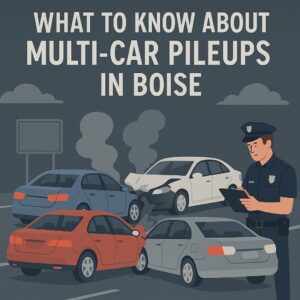Multi-car accidents can bring traffic to a halt, but the legal fallout lasts far longer. A recent pileup on westbound I-84 in Nampa caused major delays after vehicles lost control on icy roads. These types of collisions are chaotic, dangerous, and often legally complicated.
In Boise, multi-vehicle crashes are more than just large-scale traffic events. Each driver may offer a different account of what happened, and liability often depends on fine details like driver behavior, weather conditions, or the chain of impacts. With more drivers, more insurers, and more injuries involved, proving who’s at fault becomes harder — and more urgent for anyone seeking compensation.
Overview of Multi-Car Pileups in Boise
A multi-car pileup involves three or more vehicles in a chain reaction crash, often set off by one initial impact. These collisions typically happen on high-speed roadways such as I-84, where a single driver’s error can quickly escalate into a multi-vehicle disaster.
Ada County recorded the highest number of crashes in Idaho in 2023, with more than 9,200 collisions reported. That accounts for nearly 30 percent of all crashes in the state. These incidents often result in serious injuries, overlapping insurance claims, and significant vehicle damage. Unlike two-car collisions, which often have a clearly responsible party, multi-vehicle crashes involve a complex mix of contributing factors and perspectives. Sorting out who did what requires careful review by law enforcement, insurers, and sometimes third-party crash investigators.
Factors like traffic congestion, weather, and reduced visibility make Boise-area highways especially vulnerable. Vehicles often strike one another in quick succession, making it difficult for drivers to react or even understand what triggered the crash. Some drivers may be stationary when hit, while others contribute to the pileup through panic braking or lane changes. These variations in position and behavior complicate both investigations and legal claims.
Investigating the sequence of events, driver actions, and roadway conditions is essential for identifying who was responsible and how liability is shared. This step is often key to building a successful injury claim in Boise.
Understanding Legal Complexities
Multi-car crashes rarely involve a single cause or clearly identifiable at-fault driver. Multiple parties often contribute through acts like tailgating, speeding, or failing to adjust for road conditions. Idaho’s comparative negligence law allows fault to be shared, but drivers found 50 percent or more responsible are barred from recovering compensation.
Legal complexity increases when multiple insurance companies become involved. Each insurer may reach a different conclusion about fault, especially when coverage overlaps or injuries are severe. When government agencies or commercial trucks are involved, even more legal standards and procedures may apply. All of this slows the claims process and increases the chances of disputes, especially for victims trying to recover damages.
Determining Liability in Multi-Vehicle Crashes
Liability in a pileup is often unclear because evidence may point to multiple negligent drivers. Investigations typically begin with the police report, which may include diagrams and witness statements. However, these reports are not always complete or accurate in large, chaotic scenes.
Insurance adjusters examine physical damage, skid marks, dash cam footage, and weather data. In some cases, experts reconstruct the crash using vehicle positions and impact angles. A driver who rear-ends another car may be at fault, but circumstances like sudden lane changes can shift blame. Idaho law assigns liability based on each party’s share of negligence, and drivers found to be mostly at fault are not eligible for compensation — even if injured.
Gathering Evidence to Prove Fault
Strong evidence is essential for proving fault in a multi-vehicle crash. While the police report provides an initial account, supporting documentation often carries more weight when claims are contested. The following types of evidence can be critical:
- Police reports include diagrams, citations, and early statements. They offer a starting point but may be incomplete.
- Photographs and video footage from dash cams, phones, or security cameras provide visual context on road conditions and vehicle positioning.
- Eyewitness statements from neutral bystanders can confirm or contradict claims and help establish timelines.
- Vehicle data and damage reports from onboard systems can reveal speed, braking, and steering input before impact.
- Weather and road condition documentation such as traffic camera images, weather logs, or 911 transcripts can support the role of external factors.
When collected promptly and organized well, this evidence makes it easier to determine who contributed to the crash and to what extent.
How You Can Strengthen Your Legal Position After a Pileup
The steps you take immediately after a pileup can influence how your case is evaluated, even before a claim is filed. What you say, what you document, and what you leave out may shape the way insurers and investigators assign responsibility.
Avoid speculation when speaking with police or insurance representatives. Stick to the facts and request copies of all documents related to the crash, including police reports and your own insurance file. Review these records carefully. Discrepancies or assumptions in early reports can snowball into larger legal issues if left unaddressed.
Many may be unsure of how to protect your claim or challenge an inaccurate report. Speaking with a local car accident attorney can help. They can clarify how Idaho’s comparative fault rules apply to your situation and help you avoid mistakes that might reduce your compensation. By acting early, staying organized, and getting the right guidance, you protect your right to fair treatment—regardless of how many drivers were involved.







